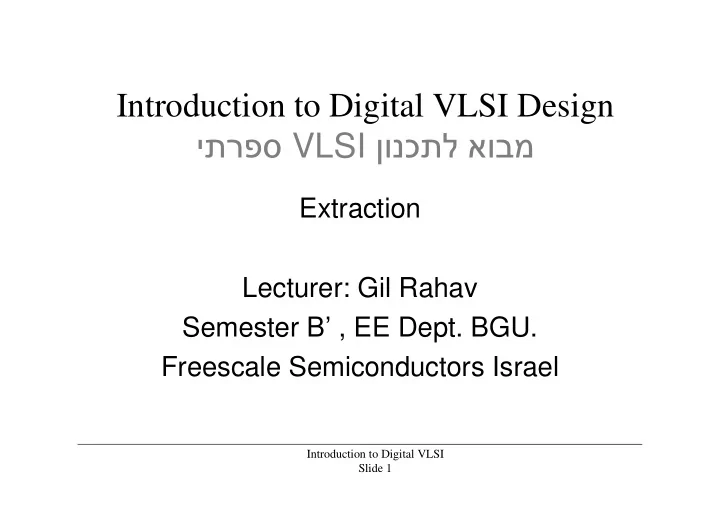

Introduction to Digital VLSI Design �יתר�פס� � ��ו�נכ�ת�ל�אובמ VLSI Extraction Lecturer: Gil Rahav Semester B’ , EE Dept. BGU. Freescale Semiconductors Israel Introduction to Digital VLSI Slide 1
Extraction • Extraction is a process of creating electrical representation (R&C) for layout interconnect Resistance & Capacitance • Extraction could be done in two ways: 1. transistor level extraction 2. cell level extraction Introduction to Digital VLSI Slide 2
Delay calculation Total delay = device delay + interconnect delay + slew rate Introduction to Digital VLSI Slide 3
Basic concepts Capacitance • Area (overlap) • Fringe (edge) • Nearbody (coupling) Introduction to Digital VLSI Slide 4
Parasitic Extraction What is parasitic capacitance? • Electrical side effect depends on the shape of the signal and its neighborhood. • Parasitic capacitance occurs both between geometries on a single layer and between geometries on different layers. Introduction to Digital VLSI Slide 5
What is parasitic resistance? • Electrical side effect depend on the shape of the signal and resistivity of the interconnect layer Introduction to Digital VLSI Slide 6
Grounding coupling capacitors 20 pF 20 pF 20 pF RC representation: 1. C (lumped C) 2. RC (distributed RC) 3. RCC (distributed RC + coupling) Introduction to Digital VLSI Slide 7
Layout formats • GDSII (stream) raw geometrical shapes • LEF / DEF geometric shapes + netlist Introduction to Digital VLSI Slide 8
GDSII format • Raw geometric shapes (polygons, paths) at diffrenet layers • Texts (net names, pin names) at different layers • Cell instances Available: • Always Connectivity: • Requires connectivity analysis and LVS Introduction to Digital VLSI Slide 9
LEF (abstract) • Cell boundary • Cell pins with names and locations • Obstructions (used routing area) Introduction to Digital VLSI Slide 10
DEF • Represents one level of layout • Netlist, pins locations, cells placement, routing annotated per net • Connectivity • All the information embedded inside the LEF/DEF; no need for special processing � Available from automatic P&R tools Introduction to Digital VLSI Slide 11
RC Formats • DSPF (= SPF) – most often used • SPEF • SPICE • SBPF (for PrimeTime only) Introduction to Digital VLSI Slide 12
DSPF • resistance and line capacitance of each segment in a net in a SPICE format Non SPICE statements: • *|NET NetName NetCap • *|I (InstancePinName InstanceName PinName PinType PinCap X Y) • *|P (PinName PinType PinCap X Y) • *|S (SubNodeName X Y) Introduction to Digital VLSI Slide 13
Net name and *|NET cpm_ips_rdata[2] 0.129244PF total capacitance Port node *|P (cpm_ips_rdata[2] O 0 834.39 -0.27) *|I (sba_env:cpm_ips_rdata[2] sba_env cpm_ips_rdata[2] B 0 317.67 90) Net nodes Instance pin *|I (sbs_env/sbs_top:sbs_ips_rdata[2] *+ sbs_env/sbs_top sbs_ips_rdata[2] B 0 156.51 90) *|S (cpm_ips_rdata[2]:9) Subnode Cg1540 sba_env:cpm_ips_rdata[2] 0 1.16035e-14 Cg1541 cpm_ips_rdata[2] 0 5.46695e-14 Capacitors Cg1542 cpm_ips_rdata[2]:9 0 1.1831e-14 Cg1543 sbs_env/sbs_top:sbs_ips_rdata[2] 0 5.114e-14 R1189 cpm_ips_rdata[2]:9 sbs_env/sbs_top:sbs_ips_rdata[2] 30.2 Resistors R1190 sba_env:cpm_ips_rdata[2] cpm_ips_rdata[2]:9 11.34 R1191 cpm_ips_rdata[2] cpm_ips_rdata[2]:9 25.8727 sba_env:cpm_ips_rdata[2] cpm_ips_rdata[2] sbs_env/sbs_top:sbs_ips_rdata[2] Introduction to Digital VLSI Slide 14
Extraction tools • xCalibre (GDSII) • Calibre2Star (GDSII) • StarXT (LEF / DEF) Introduction to Digital VLSI Slide 15
Target tools • Timing Analysis tools (Cell and Trasistor Level) • Noise • Power grid • Circuit Verification Tools Introduction to Digital VLSI Slide 16
The Flows – Cell Level • Transistor level extraction on GDSII • LVS required • Usually extract capacitance only • Used for characterization, or in transistor level analysis tool with cell level block extraction Introduction to Digital VLSI Slide 17
The Flows – Block Level Transistor Cell level level Transistor Transistor level level Introduction to Digital VLSI Slide 18
Chip level • extraction on LEF/DEF down to block boundaries • no LVS required • extract RC • extraction tool - StarXt • analysis tool - PrimeTime • backannotation - no need • reduction - done on-the-fly • need to define context to model inside blocks routing if obstructions do not exist Introduction to Digital VLSI Slide 19
Recommend
More recommend